8 Trusty Types Of Dogwood, Including Garden Writer Nic Wilson’s Favourites

Reviewed By ROY NICOL

Roy is a Professional Gardener and Horticultural Consultant, specialising in large garden year-round maintenance and garden development. He is an RHS Master of Horticulture and uses his research in the application of no-dig methods in ornamental garden settings. Roy has been a Professional Gardener for more than six years and is a member of the Chartered Institute of Horticulture, Professional Gardener's Guild and Association of Professional Landscapers (Professional Gardener).
Contributions From NIC WILSON

Nic Wilson is a Garden Writer best known for her work at BBC Gardeners' World Magazine and for her position at The Guardian’s Country Diarist. She is currently writing her memoir and is awaiting the publication of her anthology in the Moving Mountains journal. Nic was shortlisted for the Beth Chatto Environment Award in 2019 and the Spread the Word 2021 Life Writing Prize Longlist.
IN THIS GUIDE
DOGWOOD GUIDES
Cornus is quite a cosmopolitan genus.
Species are native to all of North America, Europe, and nearly all of Asia except for Kazakhstan and its surrounding countries and India.1Dogwood (Cornus sanguinea). (n.d.). Woodland Trust. Retrieved March 15, 2023, from https://www.woodlandtrust.org.uk/trees-woods-and-wildlife/british-trees/a-z-of-british-trees/dogwood/
Species also grow in regions of Eastern-Central Africa and the north-western hump of South America.
All of the desirable Dogwood tree varieties are Far Eastern or American ones.
“I think I’d find it hard to be cheerful in the colder months without my dogwoods,” says Nic Wilson, a Garden Writer.
“Winter is the season when I need the lift that comes from seeing a blazing mass of ‘Midwinter Fire’ or the morning light shining on the vivid green ‘Flaviramea’ stems in the borders.”

The total number of species in Cornus number about 50-60 (not including hybrids and cultivars) – most of them are deciduous but a few are evergreen.2Atkinson, B. S., Stockey, R. A., & Rothwell, G. W. (2016). Cretaceous origin of dogwoods: an anatomically preserved Cornus (Cornaceae) fruit from the Campanian of Vancouver Island. Peer J, 4, e2808. https://doi.org/10.7717/peerj.2808
Dogwood trees are cherished in many regions of the United States and some even claim it for their own, as has Virginia: a Dogwood species, Cornus florida, is the state tree and its ‘bract flower’ is the state flower.3American Dogwood. (2017, December 26). State Symbols USA. Retrieved March 15, 2023, from https://statesymbolsusa.org/symbol-official-item/virginia/state-flower/american-dogwood
Varieties of Dogwood trees differ in the colours and types of their small or insignificant flowers encircled by much more attractive and colourful bracts, the hues and edibility of their berries or drupes, and by the kind of colours they may display in autumn.

The simple leaves are usually ovate and opposite, and of a mid-green to dark green tone.
The aim of this section is not to list the most popular or most desirable varieties, and it is certainly not meant to provide an exhaustive list.
Rather, the intention is to illustrate the enormous diversity in size, form, and seasonal display of colours.
By ‘flowers’ we refer to the more attractive colourful bracts.
1) Kousa

Botanical Name: C. kousa
Originating in China, Japan and the Koreas, is the species from which the majority of the most popular and desirable cultivars descend.
It typically reaches a height of about 7m.
In spring it produces a lush display of greenish-white flowers that are often pink-tipped, with light red berries following in summer.
In autumn there is another lovely display of deep reds and purples.
In winter this species’s patchy, somewhat scaly, tan-coloured bark comes into view.
2) Dogwood ‘Wietings Select’
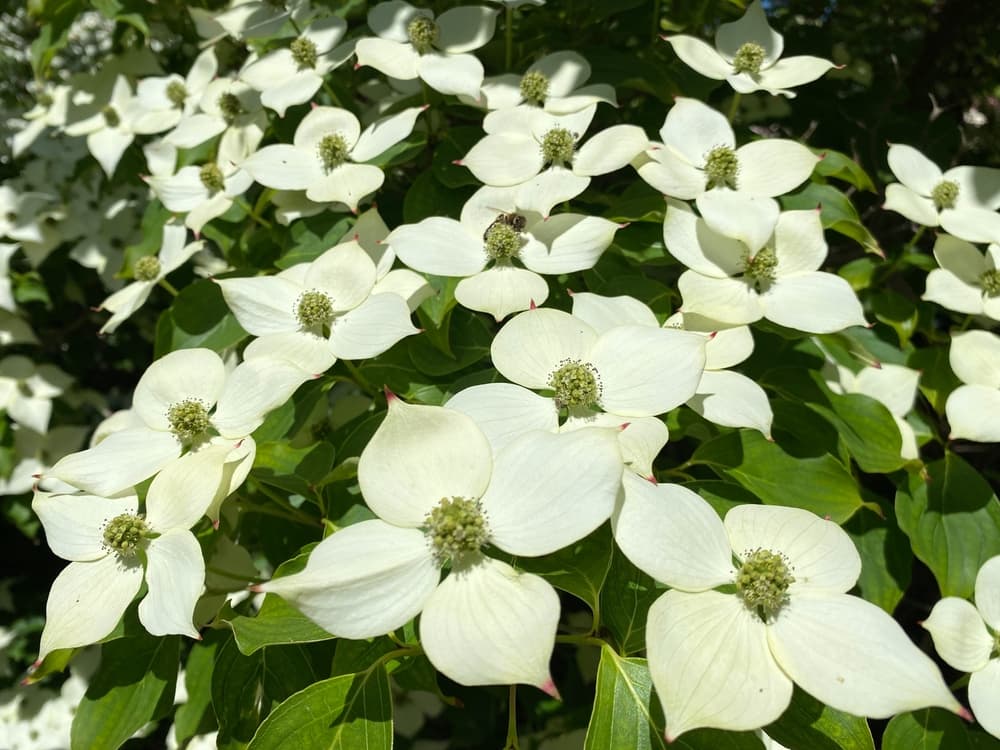
Botanical Name: C. kousa var. chinensis ‘Wietings Select’
Also grows to about 7m.
Its flowers are pure white, developing pink edges and tinges, and the late summer berries are a saturated tone of pink.
In autumn the foliage puts on an amazing show of deep, rich reds.
3) Kousa ‘Miss Satomi’
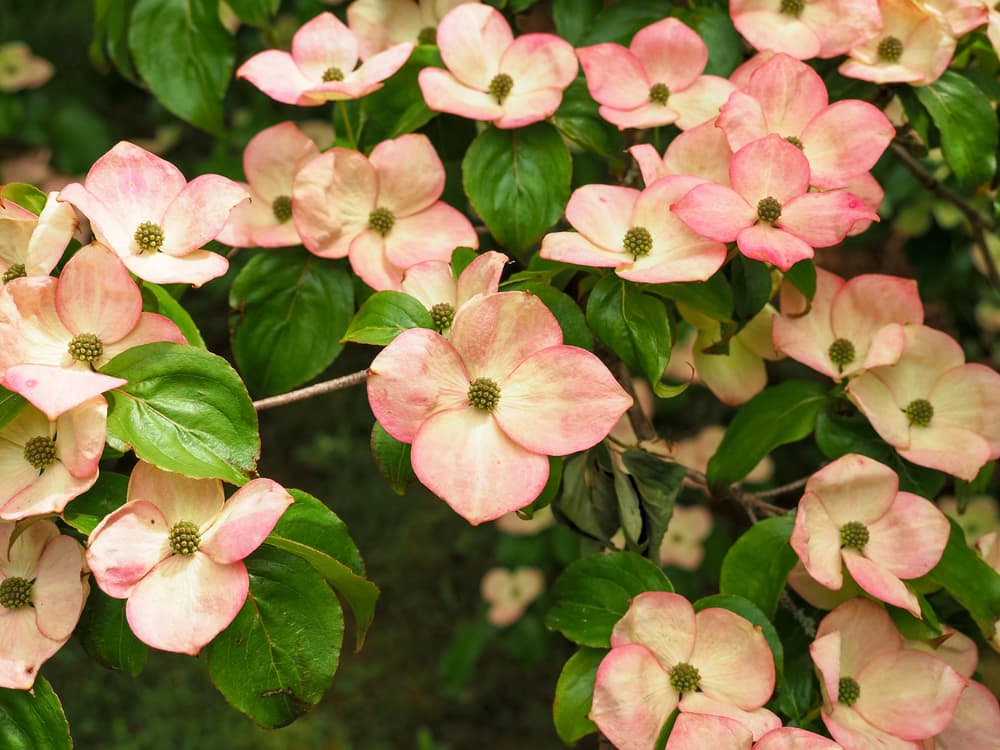
Botanical Name: C. kousa ‘Satomi’
Grows to your choice of a small tree of 4-5m or a tall shrub.
It is covered by candy pink flowers in summer.
More colour follows in autumn as the (inedible) fruit and the foliage both present attractive tones of light and rich reds.
RHS Award of Garden Merit.
Many other Kousa cultivars are available, ranging in height from 4-8m, and producing foliage, flowers, and berries in various appealing light and dark colours.
4) Stiff Dogwood
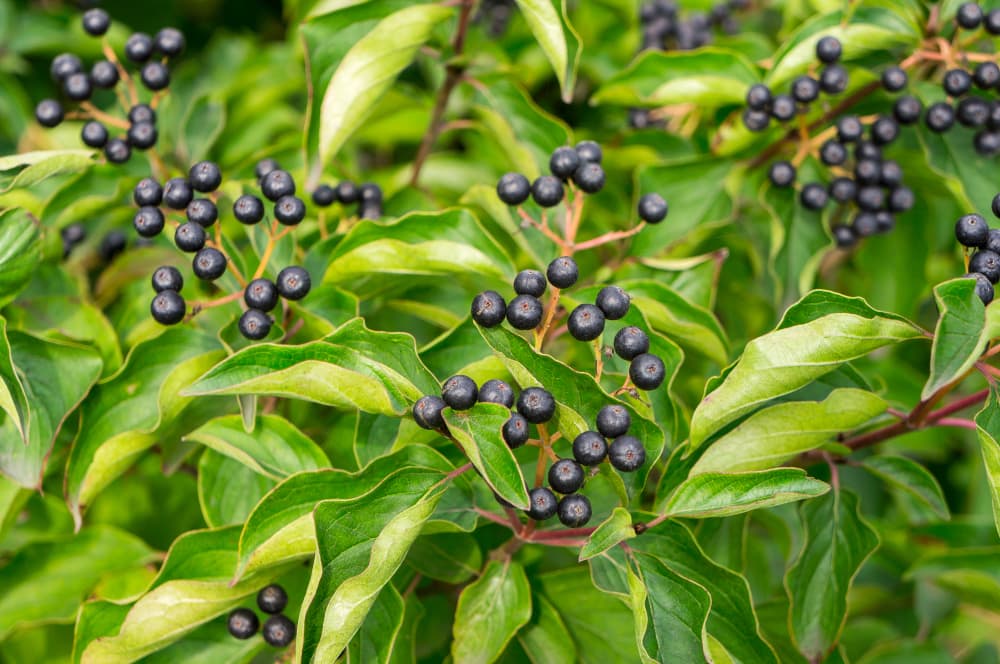
Botanical Name: C. foemina
Also gives you a choice between growing it as a small tree of 6-7m or a tall shrub.
Its flowers are white and relatively small and in autumn the foliage display includes deep and rich hues of wine red and purples.
But the twist on this tree is that its late summer berries are blue, and a popping tone of blue at that.
5) Flowering Dogwood

Botanical Name: C. florida
Is the ‘main’ American species which grows to about 7m.
In mid-spring it starts to produce an abundance of white or pinkish flowers, followed by vermilion or light red berries in late summer.
Autumn brings a blaze of reds and purples as the foliage changes colour.
This species is, unfortunately, the most susceptible to cornus anthracnose.
6) Flowering Dogwood ‘Sunset’
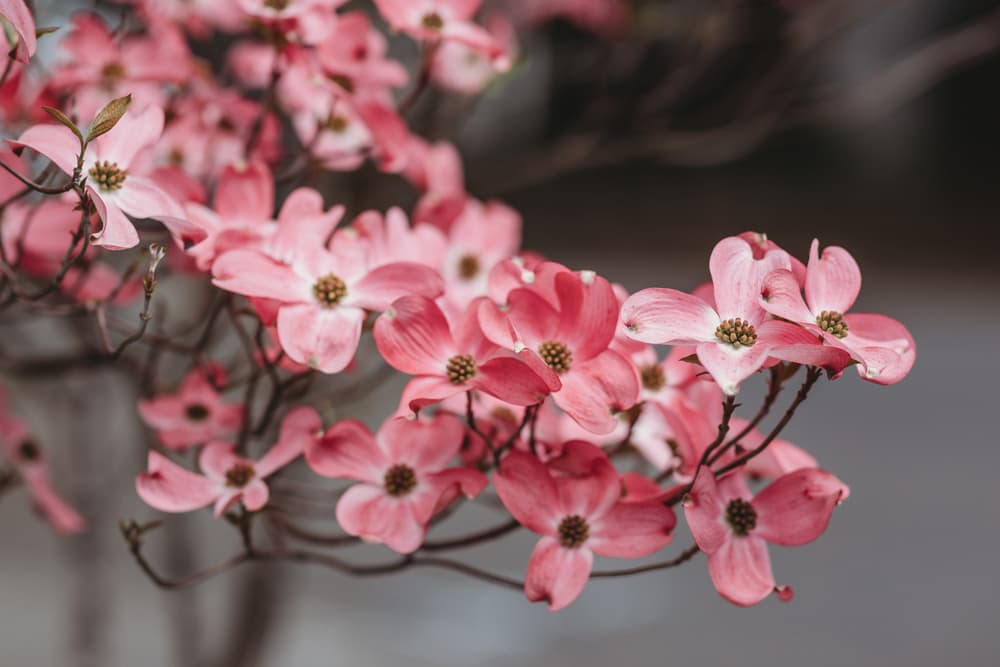
Botanical Name: C. florida ‘Sunset’
Grows to about 7m and ‘improves’ upon the mother species in both foliage and flowers.
The leaves are wonderfully variegated, being bright green in the centre with a substantial edging of bright yellow.
Late spring and early summer bring bright pink flowers, often with white flushes.
The late summer and early autumn show comprise of red berries, with the foliage turning reddish-purple as the season progresses.
7) Giant Dogwood
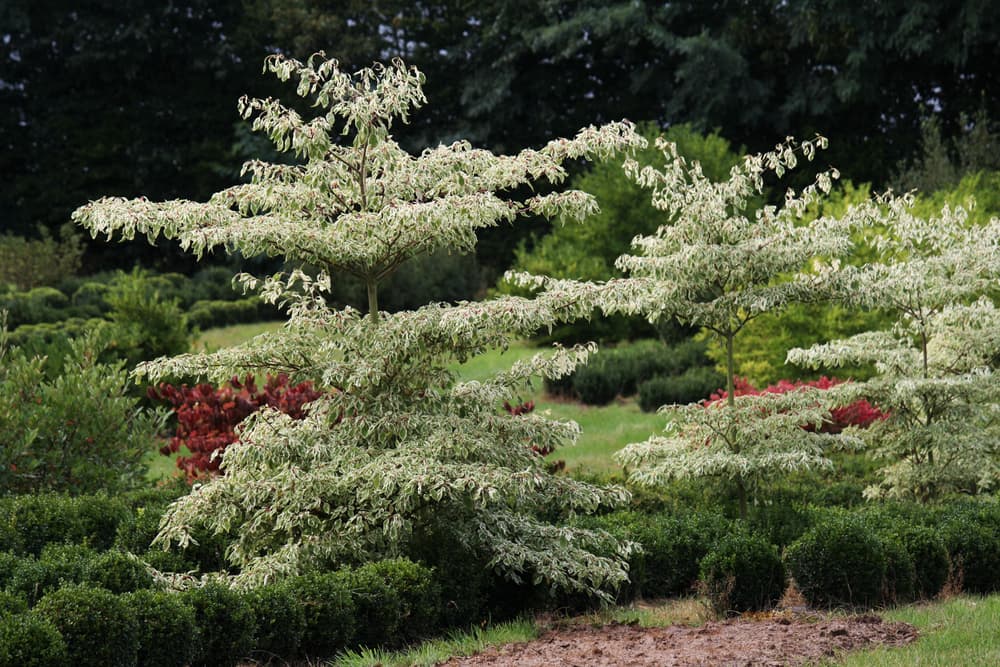
Botanical Name: C. controversa
Lives up to its name – at least where Dogwoods are concerned! – reaching 15m heights.
It has a wonderful tiered branching pattern that can be observed in winter when the tree is bare but admired even more when it is in flower.
And those flowers are plentiful and of a very rich creamy shade.
Autumn brings different colours as the berries on this tree are blue-black while the leaves display shades of purple and violet.
8) Wedding Cake Tree

Botanical Name: C. controversa ‘Variegata’
A smaller version of C. controversa, topping out at about 8m.
This dinky tree also has that wonderful tiered branching pattern which is most marked when in full leaf.
The leaves are variegated – green in the centre with thick cream edges.
The late spring to early summer flowers are white-white and the berries following them in late summer and early autumn make the strongest of contrasts with their bluish-black colour.
RHS Award of Garden Merit recipient.
References
- 1Dogwood (Cornus sanguinea). (n.d.). Woodland Trust. Retrieved March 15, 2023, from https://www.woodlandtrust.org.uk/trees-woods-and-wildlife/british-trees/a-z-of-british-trees/dogwood/
- 2Atkinson, B. S., Stockey, R. A., & Rothwell, G. W. (2016). Cretaceous origin of dogwoods: an anatomically preserved Cornus (Cornaceae) fruit from the Campanian of Vancouver Island. Peer J, 4, e2808. https://doi.org/10.7717/peerj.2808
- 3American Dogwood. (2017, December 26). State Symbols USA. Retrieved March 15, 2023, from https://statesymbolsusa.org/symbol-official-item/virginia/state-flower/american-dogwood

